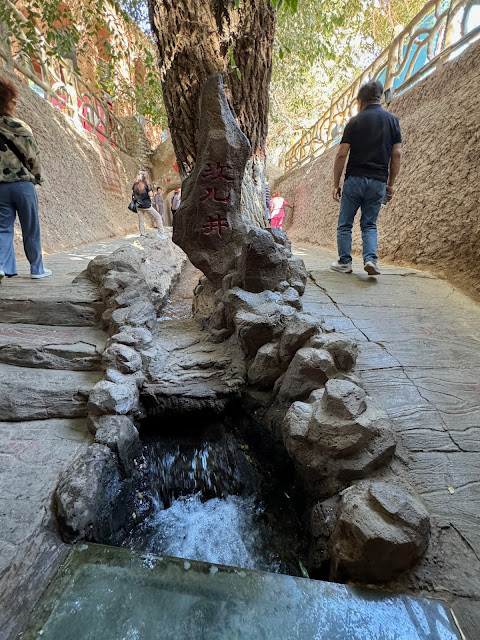We are finally at Dunhuang, the legendary city - strategically important because of its location at the crossroads of two important trade routes running north and south of the Talamakan desert. It is also situated on the western edge of the Gobi Desert and north of the Mingsha Dunes, making it an important rest stop for merchants and pilgrims from every direction. During the Han Dynasty (206 BC to 220 AD) a commandery was established there to protect the region. Pilgrims came because Dunhuang was an ancient site of Buddhist learning, evidenced by the 492 Mogao caves chock full of Silk Road history since the 4th century.
We arrived in Dunhuang at dinner time and went for a walk in the colourful night market after dinner - a good opportunity for some street photography. The following morning was dedicated to seeing the Mogao Caves. There were long line-ups early in the morning and we were thankful our special tour group request for two official guides was approved and we went straight to the caves led by the two guides. There were so many caves, everyone got to see different caves, so we were not really "cutting in line", so to speak.
I hope you won't be disappointed because photos were not allowed in the caves. I have included two photos of a replica at the Dunhuang Museum which we visited the following morning. While disappointing, I found that I actually enjoyed the break from taking photos. It helped me pay attention to every word the guide said knowing that my memory would be the only thing that I could turn to to remember this legendary spot.
The guides were extremely knowledgeable and pointed out important elements to us, including the difference between restorations done in the Tang Dynasty (619-907) versus those done in the Qing Dynasty (1614-1912). The restoration handwork and painting done during the Tang were much more refined than the more recent ones done during the Qing Dynasty - in fact after a couple of caves we were able to identify the differences ourselves. It was an intense morning focusing on the content delivered in perfect Mandarin by the guides (thankful especially because good Mandarin delivered lecture-style is much easier to understand for us non-native speakers).
The afternoon is supposed to be a relaxing visit to the Mingsha Dunes. But the obligatory camel ride has its tense moments until I reminded myself to relax and go with the bump and hump of the camel's rhythm. After the ride we visited the dunes, some visitors climbed the dunes but I settled for a walk around Crescent Lake. We spent a second night in Dunhuang, in the beautiful Silk Road Dunhuang Hotel, in itself an experience with its traditional decor and long lantern-lit corridors. It also happened to be the night of the Mid-Autumn festival and we shared moon cakes - the traditional buildings are such a romantic backdrop.
 |
| The goddess playing the Chinese musical instrument "Pipa" from behind her back is a landmark in Dunhaung city centre. It was inspired by an image in the Mogao Caves. |
 |
| Both sides of the entrance to the Dunhuang Night Market |
 |
| There were both street booths and store fronts |
 |
| The lamps here reminded me of Istanbul |
 |
| Street artists working on the spot |
 |
| Pretty teen all dressed up in local garb - seems to be the trend. The couple walking behind her could be her parents. |
 |
| A few blocks of restaurants and street food stands - quite a gathering place, not just for tourists but for locals too |
 |
| Street singer had beautiful voice that seemed much appreciated by her audience. The signs on the restarants were advertising "Almond skin tea" - I didn't see this until I look at the photos at home. Would have loved to try that. |
 |
| Dunhuang streets were decorated for the Mid-Autumn Festival |
 |
| Sunrise atop the Dunhuang Silk Road Hotel where the Minsgha Dunes were visible giving us an enticing foretaste of the upcoming visit |
 |
| Mingsha Dunes in the sunrise glow |
 |
| The Mogao Caves in their more natural state - unlike the section we were allowed to visit |
 |
The caves that are open to visitors have all been built up outside with staircases at different levels. |
 |
| This is a multistorey cave |
 |
| Some old structures are still around |
 |
| This Nine-storey Temple houses the largest sitting Buddha in Dunhuang. Built in the Tang Dynasty (695 AD), it is an indication of the prosperity and economic stability of that Dynasty. |
 |
The entrance gate to the caves |
 |
| The impressive Mogao Caves Digital Exhibition Centre which we didn't visit |
 |
he Mingsha Dunes with camel rides
|
 |
| Riders were loaned orange cloth boots which did a great job of keeping the sand out of shoes and still allow visitors to walk easily on the sand |
 |
| Crescent Moon Lake |
 |
| Almanac from the Han Dynasty on bamboo |
 |
| An exquisite window on the museum wall |
It would be 2.5 hours just to get to the LiuYuan train station from Dunhuang then another 3 hour ride on the bullet train to Turpan. Tomorrow we would be crossing the border into Xinjiang autonomous regions. Security at the train station was very tight - we had to go through security twice, just to enter the train station and then to board.
 |
| Interesting to see an RV on the highway |
 |
We had dinner on the train.
By the time we got to Turpan, the sun was setting.
Next post: Turpan, Xinjiang
|










.jpeg)


































































.jpeg)





